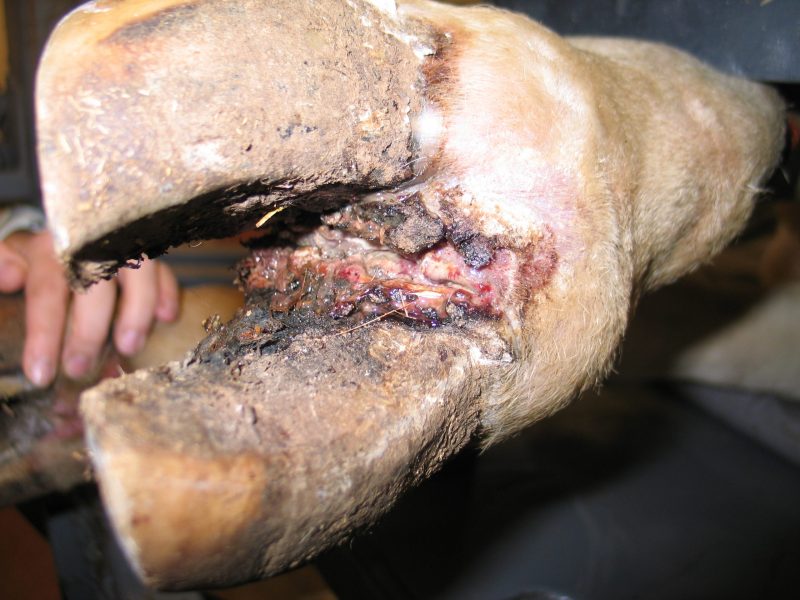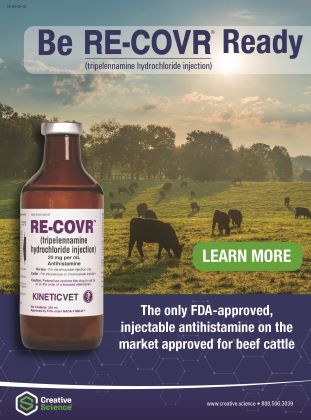Hoof Care for Dairy Cattle

More than 90% of lameness problems in cattle originate in the feet, and lameness takes a toll on herd production. Research at Michigan State University showed that lame cows were 16 times more likely to exceed herd average for days open (slower to breed back) and 9 times more likely to exceed herd average for services per pregnancy–and 8 times more likely to be culled than non-lame herdmates.
Wet weather and mud can lead to foot problems. Sole injuries, infection of the skin around the hoof, and footrot are all more likely to occur when wet conditions soften the tissues, making them more vulnerable to bruising and injury (nicks and scrapes) that open the way for infection. The animal may need antibiotics, medication to help relieve pain, and in some cases foot trimming or surgery. Pain can also be caused by overgrown or misshapen hooves or severe hoof cracks.
Dr. Andrew Niehaus, Associate Professor, Farm Animal Surgery, Ohio State University says environmental conditions and genetics are the biggest factors in whether a certain animal is at risk for foot diseases. Some animals are predisposed to problems because of their genetic makeup—either poor foot and leg conformation that puts more stress on the feet, or weaker hoof horn that’s more prone to injury. “Regardless of their environment, those animals will probably never have strong, healthy feet, compared to other cattle,” he says.
“Nutrition also plays a role. Protein, vitamins and minerals are important for normal hoof growth and strength. Deficiencies can be a factor in poor hoof growth or hoof strength. Energy metabolism is also a factor; too much concentrate in the diet can cause laminitis, just as it does in horses. Cattle on a high plane of nutrition with a diet rich in carbohydrates often develop a subclinical laminitis. This can predispose them to a myriad of other diseases,” he says.
LAMINITIS – Inflammation of the laminae–the interfacing tissues that connect the sensitive inner parts of the hoof and bone to the outer insensitive horny shell–is often due to digestive problems that upset the balance of rumen bacteria, creating toxins that may enter the bloodstream and cause serious changes in the hoof. Most common causes of laminitis are grain overload or sudden changes in diet. Just as in a horse with laminitis, the cow’s feet become tender due to the inflammation. If the affected laminae separate, disrupting the connection of bone to hoof horn, the feet become deformed as the bone shifts and growth patterns change–with toes becoming overlong and curling upward. An animal that has foundered will always tend to go lame easily, due to sole bruising.
“Even though they may not develop the severity of clinical signs like a horse (the bone sinking inside the hoof or sloughing the hoof horn) inflammation of the laminae will make the feet sore,” says Niehaus. “Affected cattle might have mild lameness, and also produce poor quality hoof horn, which leads to other problems like white line disease, sole ulcers, abscesses, etc. The hoof horn is softer and more easily bruised, or more at risk for white line disease or penetration of the foot by foreign bodies—which can lead to infection in that area.”
Therefore proper diet is important. Cattle need adequate levels of the important nutrients (the building blocks for strong, healthy hoof horn) but at the same time avoiding high levels of grain and carbohydrates.
SOLE BRUISES AND ABSCESSES – The other big factor is environment. “If cows are on hard, abrasive or sharp surfaces like concrete or gravel, hoof injuries are common. Sharp rocks, stubble, ice, etc. may poke into the foot. If cattle are continually on concrete, over time there may be abnormal abrasion and wearing of the bottom of the hoof. At the other extreme, wet muddy/boggy conditions are also damaging; excessive moisture softens the hoof horn and makes it more prone to injury.
“Here in Ohio it’s really wet in the spring and if cattle don’t have a high, dry place and are confined–a lot of animals in a small area–it’s a muddy mess. They may be standing in mud up past their fetlocks. Short term contact with mud (walking through water) generally won’t cause a problem, but if they are standing in mud all the time the hoof wall gets softer and more easily penetrated. If they step on a rock that wouldn’t damage a normal hoof, it may penetrate the soft hoof wall or sole. This may lead to white line disease or abscesses,” says Niehaus.
Bacteria may enter the hoof itself through a crack or bruise, usually on the bottom of one of the digits. A bruised sole (from stepping on a sharp rock, or from uneven weight-bearing due to misshapen foot) may eventually become an abscess. Sometimes the layers of the sole will separate and a “false sole” develops–with pus in between the layers. The infection may eventually break out the side or at the heel.
With an abscess, initially there is no swelling above the hoof, since the infection is confined to the hoof itself. If a lame animal does not have a swollen foot, an abscess (rather than foot rot) should be suspected and the bottom of the claws/toes should be carefully inspected. A crack or bruise should be probed with a hoof knife to find the abscess and open it up. In some cases it may need flushed and drained. The infection creates a foul-smelling fluid that will be obvious when the abscess is located and opened.
Treatment generally consists of paring away all the affected horn tissue around the abscess, and minimizing weight-bearing in that area until new horn can grow and fill in the hole. This can be accomplished by paring the affected claw so that the sound one bears the weight, or by gluing a shoe or wood block to the sound claw to build it up so it bears all the weight.
FOOT ROT – “Warm, wet environments also create ideal conditions for bacterial growth. There may be anaerobic bacteria in that mud, such as Fusobacterium necrophorum, and Porphyromonas levii which are the two commonly implicated bacterial pathogens that cause foot rot in cattle. With softened skin and hoof horn, in an environment where these pathogens are proliferating, bacteria readily gain access through the skin,” Niehaus says. “Infection and inflammation causes heat and swelling. F. necrophorum causes necrosis; there is a lot of dead and dying tissue and inflammation of surrounding tissue. This all causes pain and lameness. The dead tissue is also an anaerobic environment suitable for continued growth of these anaerobic bacteria. Foot rot infection has a foul, nasty odor because of the dead and dying tissue and the characteristic smell of these bacterial organisms.”
The good thing about foot rot, compared to some of the other hoof diseases, is it generally responds to treatment. “Some forms tend to be more virulent, but typically it responds quickly, if we catch it early. Antibiotics like penicillin (which works well for anaerobic bacteria) or oxytetracycline (broad spectrum and works well for foot problems) are usually very effective whether administered systemically or locally,” says Niehaus.
“In later stages of foot rot, infection may spread into other tissues and cause problems in the tendon sheath or even the joint if it spreads up the leg. These are more serious problems, especially if it becomes septic arthritis in the coffin joint. If that happens, the prognosis (and our ability to treat it) dramatically decreases,” he says.
WHITE LINE DISEASE – “The white line area is the junction between the bottom of the sole and the hoof wall. Where two structures come together like this, the area where they meet tends to be a weak spot. This is softer than the rest of the hoof, and more readily penetrated, especially in wet conditions when it’s even softer. Rocks and small debris may poke into those areas and create entry for pathogens that cause foot abscesses.”
In dairy cattle white line disease tends to develop in the side wall of the claws rather than at the toe. Separation at the white line can lead to abscess formation. The cause of white line disease in dairy cattle is complex and multifactorial but involves impaired blood supply for production of horn tissue and mechanical injury from walking on hard, uneven flooring such as concrete or being exposed to surfaces where debris and foreign material gets jammed up into the white line area between the outer horn shell and the inner tissues. Manure/dirt can get packed up in there. White line disease is also common when cattle are fed a lot of concentrate feeds: this area of the foot becomes soft.
“By itself white line disease may not be much of a problem, but can lead to undermining of the sole. Then this area may be prone to abscesses or lead to foot ulcers if the abscess ruptures out, or to distal interphalangeal joint infection,” Niehaus says.
Early stages may not cause lameness, but if white line disease is noticed when the foot is being trimmed or examined, it should be cleaned out with a hoof knife—before it becomes the start of something more serious.
DIGITAL DERMATITIS (HAIRY HEEL WARTS) – Digital dermatitis (DD) in cattle has often been called hairy heel warts or strawberry foot rot. Dr. Dörte Döpfer (School of Veterinary Medicine, University of Wisconsin – Madison) has done a lot of research on this disease. “This is a worldwide infectious claw disease of cattle, associated with lameness. In North America, more than 95% of all dairy farms are affected. It usually starts with outbreaks of severe ulcerative lesions at the border of the skin and horn tissue on the backside of the feet—mostly hind feet—and often shows up in heifers pre-calving. Peak occurrence is generally around breeding age, at 12 to 14 months of age,” she says.
By the time these heifers calve, they are already past the peak of infection, and enter their first lactation with chronic DD, and often have it for life. “This multifactorial disease has a strong bacterial component. Among the many bacteria associated with DD are treponemes, which are spirochetes—corkscrew-shaped bacteria that live in anaerobic locations where there is no oxygen. There are reports of other bacteria involved as well, such as mycoplasma, Porphyromonas, Fusobacterium spp. and Campylobacters. The microbes involved remain at the surface of the skin in a so-called ‘biofilm’,” she says.
These surface bacteria damage and ulcerate the skin so that trepomones can then penetrate and descend more deeply into the epidermis (the upper layer of skin) or even into the dermis. “These bacteria cause inflammation that can become so severe that the skin starts to overreact and triggers proliferation of upper layers of the skin. This is what we call ‘hairy heel warts’, because of the hair-like protrusions.
Risk factors include confined groups with bad hygiene conditions. “Preventive measures are often used, such as footbaths, but my research has found that footbath chemicals are sometimes detrimental. Copper sulfate is often used, but if the footbath becomes extremely acidified such as below a pH of 3 it becomes caustic and irritates the inflamed wound surfaces of affected cattle even further. Then you get more proliferation of those hairy heel wart aspects—and higher probability for outbreaks and recurrence of lesions. This is often why people think the ‘bugs’ have become resistant and footbaths are not working anymore for disinfecting the feet.”
The wrong footbath concentration actually irritate the skin to the point there will be recurrence of lesions. “We may become part of the problem, exacerbating it and causing reservoirs of DD in the cattle by using the wrong foot bath strategies. My advice is to customize the frequency and concentration of footbath applications to the dynamics of DD on the farm. We monitor emergence and occurrence of the proliferative, chronic ulcerative DD lesions and give advice as to whether the footbath strategy and topical treatment protocols are optimal for those respective farms,” she says.
“If someone designs a foot-bathing strategy, we offer a service in my lab, taking samples of the footbath solution at zero, at 50 and at 100, or whatever number of cows walk through it, and then culture that fluid. When we see a rise above 100,000 microbes per milliliter of microbes in general, we advise switching out the fluid after a certain number of cattle have passed through it. It’s not one size fits all, in terms of footbath strategy,” Döpfer explains.
Some people think that the higher the concentration and higher the frequency of putting cattle through it, the better, but this is not the case. “If we use too much, too often, it can be detrimental. We need to use the correct amount, to be able to curtail and halt the cycle of this disease, and have beneficial effect from the footbaths.” If the footbaths irritate the wound surfaces, sometimes “less is more” to avoid that irritation.
“Another part of my research was a trial in which we experimentally induced DD in Holstein Friesian steers to see the emergence of DD lesions. We used experimentally-induced lesions to infect healthy cattle, to see how this disease evolves and the benefit of prevention and control. We know there is a genetic component to DD, particularly in Holstein dairy cattle.” Some cattle seem more susceptible than others.
“In dairy cattle it has been proven that there is a multi-gene involvement. You can see family lines of cows that get it—the heifer, the mother, the grandmother, etc.” There is an ELISA test that can be utilized to test for anti-titers against the treponemes in cow’s blood. When these bacteria make contact with the blood, antibodies are formed and antibody levels measured with the ELISA test.
“We do a lot of this type of testing; we have developed the DD check app to make standardized records of DD lesions so we can go on-farm and type in what we find in terms of stages of DD,” says Döpfer.
“We also use artificial intelligence to detect DD lesions early. We put cameras at floor level or close to stand-up chutes; they can detect DD and make automated records resulting in a spreadsheet that that can be sent to a hoof trimmer or to the producer to begin treatment.”
Camera models help people detect DD earlier and help train people to recognize DD lesions. “People who do not know how to recognize the different stages of DD can be supported by these camera models. In the near future, the camera models should be working on tablets and mobile phones,” says Döpfer.
HOOF CRACKS – Sometimes called sand cracks, this problem seems to occur most often in feet that are allowed to grow too long. A crack up the center of the toe is sometimes due to poor hoof horn that tends to become dry and brittle; the hoof loses its ability to stay hydrated and flexible. Sometimes dietary deficiency (low in copper or zinc) can lead to loss of hoof quality, and subsequent cracking.
In some regions, high levels of iron, molybdenum or sulfur may tie up copper and accentuate copper deficiency. Forages growing on alkali ground may also be low in copper and zinc. Excessive selenium in diet can also lead to hoof cracks, and in severe cases, loss of the entire hoof wall. Many areas of the country are deficient in selenium, but there are a few places where selenium levels are high enough to be toxic, causing loss of tail hair and severe hoof cracks. Over-supplementing with selenium can also cause hoof cracks, since the window of healthy levels for this important trace element is small. Too much is just as detrimental as too little.
If hoof cracks become deep, or the hoof wall starts to split at the toe, they can lead to infection of the deeper tissues and severe lameness. Toes that grow overlong often tend to crack, so keeping the foot trimmed (if it can’t wear normally) can usually keep cracks from becoming a serious problem.
HOOF TRIMMING – Most dairies utilize the services of a hoof trimmer to help keep feet properly trimmed and maintain hoof health. Randy Hettinga in Kuna, Idaho own a dairy cattle hoof health company called Professional Hoof Trimming. The primary focus is to help dairy farms maximize hoof health by providing on-site maintenance hoof trimming and lameness treatment, as well as offering training services, and consultation services.
He works with some farms weekly. “I do a maintenance trim for them which consists of inspection and basic trimming, cleaning and checking for diseases or anything abnormal. I trim during the cows’ dry period after they are about 7 months pregnant.”
While he is there, he trims and treats any lame cattle brought to him to look at. “If a cow becomes lame between my weekly visits I take time to go back and treat those cows so they are not waiting for treatment.” Ideally you want to catch lameness issues early, when the cow first starts showing any discomfort or gait abnormality.
Some cows don’t show much lameness until the condition has progressed, but a trained eye and an observant staff can pick up on subtle changes and take a closer look. Some hoof health issues are specific to individual farm procedures, while some issues occur regardless of farm protocols. Sometimes, just having a fresh set of eyes look at the situation can help.
“Foot rot responds well to systemic antibiotics. We often do a topical treatment for digital dermatitis. We try to get away from much use of topical antibiotic treatments due to pressure for producers to use fewer antibiotics. Today I no longer use antibiotics topically and don’t use antibiotics at all except in some cases of foot rot,” he says.
“I also find sole ulcers and sole abscesses in dairy cows. These are more likely to occur if there is overcrowding and cows are on concrete much of the time. This can also contribute to laminitis and sole hemorrhaging. These conditions often require an orthopedic block. If one claw is affected, we can put a block on the other one so it takes all the weight and relieves pressure on the painful one,” he says.
Other hoof problems include heel abscesses and injuries. “About 10% of lameness cases are caused by injury. When grouped together, cows are competitive and tend to fight.” While pushing each other around they may scrape their feet along the concrete. This can also happen when they are being herded too aggressively.
“Beef cattle tend to have stronger feet, less likely to be injured. Dairy cows are selected and fed to produce a lot of milk, and feet are not always the best. Great strides have been made in genetics, and in management for cow comfort, to try to mitigate some of these problems, but they still exist,” says Hettinga.
“It helps to keep a good eye on your herd and detect foot problems before the cow becomes severely lame. It’s also important to have proper treatment and trimming. It’s good to have an area close to the milking barn to work on hoof problems and a clean, comfortable place to house them during lameness and after they are treated. This can help minimize stress and discomfort.” Any time an animal is uncomfortable or in pain, this increases stress and hinders health and milk production.
By Heather Smith Thomas




